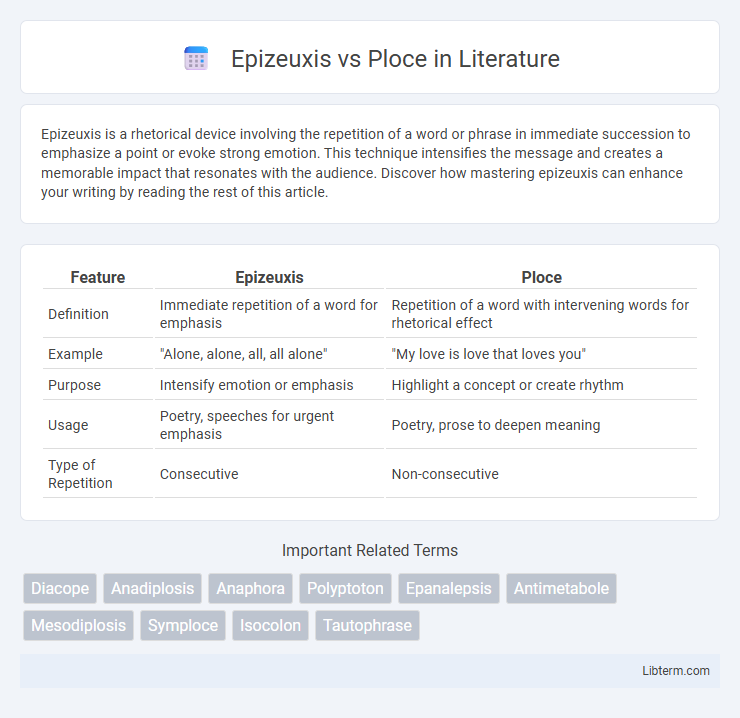Epizeuxis is a rhetorical device involving the repetition of a word or phrase in immediate succession to emphasize a point or evoke strong emotion. This technique intensifies the message and creates a memorable impact that resonates with the audience. Discover how mastering epizeuxis can enhance your writing by reading the rest of this article.
Table of Comparison
| Feature | Epizeuxis | Ploce |
|---|---|---|
| Definition | Immediate repetition of a word for emphasis | Repetition of a word with intervening words for rhetorical effect |
| Example | "Alone, alone, all, all alone" | "My love is love that loves you" |
| Purpose | Intensify emotion or emphasis | Highlight a concept or create rhythm |
| Usage | Poetry, speeches for urgent emphasis | Poetry, prose to deepen meaning |
| Type of Repetition | Consecutive | Non-consecutive |
Introduction to Epizeuxis and Ploce
Epizeuxis is a rhetorical device characterized by the immediate repetition of a word or phrase for emphasis within a sentence, intensifying the emotional impact. Ploce involves the deliberate repetition of a word with a slight variation or inserted phrase, creating a nuanced emphasis that influences meaning. Both techniques are vital in literary and rhetorical contexts to enhance expressiveness and engage the audience effectively.
Defining Epizeuxis
Epizeuxis is a rhetorical device characterized by the immediate repetition of a word or phrase for emphasis, such as in the phrase "Never, never, never give up." This technique intensifies the emotional impact and draws attention to the repeated term within close proximity. In contrast, ploce involves the repetition of a word or phrase with other words intervening, allowing for a layered or developed meaning across a sentence or passage.
Defining Ploce
Ploce is a rhetorical device involving the repetition of a word or phrase within close proximity to emphasize a particular meaning or create a stylistic effect. Unlike epizeuxis, which repeats words immediately one after another without interruption, ploce strategically separates repetitions to highlight different nuances or contexts. This technique enhances clarity and impact by allowing the repeated word to convey multiple related ideas in a text.
Key Differences Between Epizeuxis and Ploce
Epizeuxis involves the immediate repetition of a word or phrase without any intervening words, intensifying the expression, such as in "Alone, alone, all all alone." Ploce, on the other hand, features repetition of a word with intervening words, highlighting a particular concept or idea, as in "My heart is in the heart of the city." The key difference lies in epizeuxis's continuous repetition versus ploce's spaced repetition emphasizing meaning and thematic significance.
Historical Origins and Literary Usage
Epizeuxis, originating in ancient Greek rhetoric, involves the immediate repetition of a word or phrase for emphasis, as seen in classical works like those of Homer and Cicero. Ploce, also rooted in Greek and later Latin literature, extends repetition beyond immediate succession to highlight meaning or create a thematic connection, famously employed by Shakespeare and Milton. Both techniques have shaped literary traditions, with epizeuxis intensifying emotional impact and ploce enhancing conceptual depth across poetry and prose.
Epizeuxis in Classic and Modern Literature
Epizeuxis, the immediate repetition of a word or phrase for emphasis, is a powerful rhetorical device found in classic literature, exemplified by Shakespeare's "O horror, horror, horror!" in Macbeth. In modern literature, Epizeuxis continues to create intensity and emotional impact, as seen in works by contemporary authors like Toni Morrison, who uses repetition to deepen mood and character voice. Unlike Ploce, which involves repetition with intervening words, Epizeuxis is characterized by its compactness and directness, making it particularly effective for dramatic and poetic emphasis.
Ploce in Poetry and Prose
Ploce in poetry and prose involves the repetition of a word with a deliberate pause or intervening phrase, enhancing emphasis and creating rhythmic complexity, unlike epizeuxis which features immediate repetition without interruption. This rhetorical device allows writers to deepen meaning and evoke stronger emotional responses by layering significance within the repeated term. Examples in literature often reveal how ploce enriches narrative texture, making it a powerful tool for thematic reinforcement and stylistic nuance.
Effects on Tone and Emphasis
Epizeuxis intensifies tone by repeating a word in immediate succession, creating a sense of urgency or heightened emotion, as seen in phrases like "Alone, alone, all all alone." Ploce spreads repetition across a sentence or passage, allowing for strategic emphasis that deepens meaning and encourages reflection without the abruptness of direct repetition. Both devices enhance emphasis but shape tone differently: epizeuxis pulses with immediacy, while ploce builds resonance over time.
Common Examples of Epizeuxis and Ploce
Epizeuxis features the immediate repetition of a word or phrase for emphasis, as seen in Shakespeare's "Alas, alas!" from *King Lear* or Martin Luther King Jr.'s "I have a dream, I have a dream." Ploce, on the other hand, involves the repetition of a word in different senses or contexts within close proximity, illustrated by the phrase "Give me a container; I need a container" or "Make yourself comfortable in your new home, your home of peace." Understanding these common examples highlights how epizeuxis intensifies emotion through rapid repetition, while ploce emphasizes nuanced meaning by varied usage of the repeated term.
Choosing the Right Device: Epizeuxis vs Ploce
Choosing the right rhetorical device between epizeuxis and ploce depends on the desired emphasis and rhythm in writing or speech. Epizeuxis involves the immediate repetition of a word to create intensity and urgency, as seen in examples like "Alone, alone, all all alone." Ploce, on the other hand, repeats a word with intervening text to build emphasis through semantic layering, exemplified by phrases such as "I am that I am," allowing deeper reflection on meaning.
Epizeuxis Infographic

 libterm.com
libterm.com